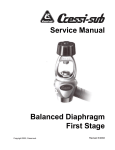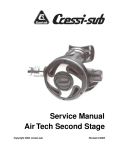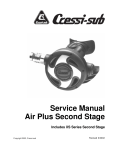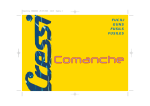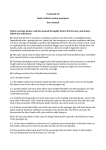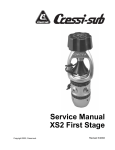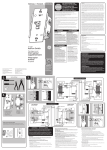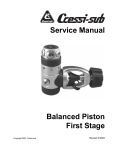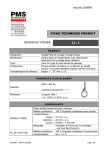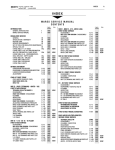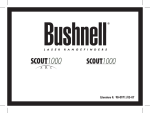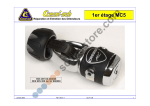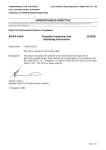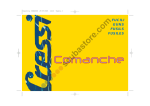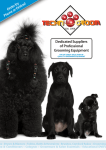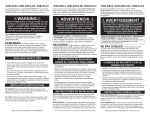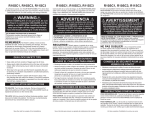Download Manual - Scubastore
Transcript
Copertina COMANCHE 28-09-2005 14:40 Pagina 2 FUCILI GUNS FUSILS FUSILES Cressi Comanche Inglese 27-09-2005 14:57 Pagina 16 6 User's manual for Cressi-sub Comanche spearguns Congratulations! The product you purchased is the result of continuous research and development carried out by our technical departments joined to the well-known Cressi-sub reliability. The new Comanche speargun comes from the long "Apache" experience in the professional field: it is made of the highest quality materials to increase its reliability and strength, even in the long run. 1. Description WARNING Carefully read this user's manual before using the speargun, and store it for future reference. Basic elements The speargun handle, made of different materials, is gummy and anatomical for a better grip. Its sturdy and simple mechanism (triggering casing) is of "box" type to make maintenance easier, and to allow its replacement in case of failure. The speargun barrel is made of high-rigidity aluminium, suitably protected against corrosion, or of a high-rigidity carbon alloy. The speargun head (or ferrule) allows fastening of two threaded rubber strands and/or of an additional third rubber strand through the appropriate hole. The compact speargun design makes sighiting easier. The rubber strands, made of highly pure latex, are supplied in different diameters, different hardness values, and different lengths depending on needs and on the fishing type. Each speargun has an ideal type of rubber strand which is different as a function of the speargun length and the fishing type; for instance, a too stretched strand may loose its properties, reducing both performance and duration. The threaded nose is made of high tensile steel and is articulated to provide longer duration. The rod, made as well of high tensile stainless steel, underwent a special treatment to ensure better hardening. It is supplied in different diameters and lengths. The Comanche line is a highly flexible plaited cord, highly resistant to rubbing. The Comanche Carbon is equipped with a wound multifilament 3.5 mm kit, similar to the traditional fishing cord, although it is more resistant, and provided with relevant rivets. Cressi Comanche Inglese 27-09-2005 14:58 Pagina 17 7 2. Components 1. 2. 3. 4. 5. 6. 7. 8. Barb. Head (or ferrule). Rod. Lateral line release mechanism. "Box" mechanism (triggering casing). Safety. Charging support. Hole for reel line or for line-to-speargun fastening 3. Operation The Comanche is a rubber strand speargun, i.e. it gives propulsion to the rod by stretching some latex rubber strands screwed to the speargun head, which extend until they fasten to the rod, through the articulated nose. 4. How to charge the speargun. WARNING Do not charge or discharge the speargun in the air! Carry out these operations only in the water in order to guarantee your safety. Never fire from air to water! 9. 10. 11. 12. 13. 14. 15. Rubber strands. Articulated nose. Line. Reel support. Reel (optional). Central automatic line release mechanism. Line-to-buoy connection ring. To charge the speargun, slide the rod through the head hole until its end is fitted into the release mechanism; then, make sure the rod is perfectly anchored in the triggering casing. Then, once the rod is perfectly fitted in its housing, keep the cord in place within the pliers, then stretch the rubber strands. To do this, lay the speargun handle "charging suapport" on your chest, while keeping one of the strands in place with your hand. Keep firmly the speargun to prevent it from sliding. Then, lightly stretch one Cressi Comanche Inglese 27-09-2005 14:58 Pagina 18 8 rubber strand in such a way to take the second strand with the other hand. Once you have kept both strands in place, stretch them until the articulated nose reaches the first notched rod connection; if necessary, and if you want to obtain greater strength, you can stretch the strands until the articulated nose reaches the second notch of the rod. 4.1 Firing 5. Multifilament installation If you want to use both the line and the wound multifilament on the speargun (Comanche and Comanche Carbon versions), it is recommended to use rivets, and to always avoid knots which are much less stable. First of all, use brass or copper rivets whose diameter does not exceed twice the diameter of the cord to be used: in this way, the speargun, once it is riveted, will not hang on the head, upon firing. Then, it is recommended to follow the steps listed below: 1 Thin the cord ends. 2 Always leave a loose noose, both at the rod end and at the head end. Once charged, the speargun is ready for fishing. In order to sight, it is recommended to keep the rod end as a reference point, and to keep your arm stretched and completely still to prevent recoil from jeopardizing fire precision. Before firing, make sure that the fire locking safety is not enabled, and that there are no people in front of your field of view. CAUTION: Never charge the speargun out of the water, because this highly increases its strength and, if the speargun should fire when the cord is stretched, it could bounce, thus causing serious injury to the user. The speargun is a very strong weapon: do not use it for purposes other than underwater fishing. The user must behave as a responsible fisher, and respect its device. Joining the line to the head 3 Rivet mounting Clinch the rivet and slightly groove it to avoid cutting it. Cressi Comanche Inglese 27-09-2005 14:58 Pagina 19 9 Knots and nooses joining the cord to the multifilament 4 Join the line to the head using a short length of twisted multifilament and fast-clearance knots. 6. Maintenance The Comanche speargun has been designed and manufactured in order to withstand any underwater operating conditions. All its metal components are made of stainless materials although some minimum maintenance is necessary to always get the best performance and long duration over time. Before using the speargun, make sure that the line has been perfectly placed, and check its conditions especially in the areas which are mostly affected by friction, and also check for solidity of all its fittings. Make sure that the rubber strands are perfectly screwed both to the head section and to the nose bushings. Lastly, make sure that the rod is perfectly straight and sharp, and check for barb mobility. During use, avoid firing toward rocks in order not to squeeze or bend the rod. Transverse firing will avoid this to a large extent. After use, it is recommended to thouroughly rinse the speargun with fresh water, carefully washing the elements which are more likely to be damaged, e.g. the rubber strands and the triggering mechanism. The latter must be very carefully checked for sand and salt inside it, which can damage the mechanism itself. During transportation, is it recommended to keep the speargun away from direct sunlight which may warm and expand some plastic components such as the rubber strand bushings which might become loose upon speargun charging. If the Comanche speargun is not used for a long time, it is recommended to loose the rubber strands thus preventing them from getting stuck, and to store them away from light, since direct exposure to the sun may accelerate the natural deterioration of the rubber strand latex. Caution: never use solvents to clean the speargun as they may damage latex and plastic too. Carefully inspect the rubber strand conditions and the bushing threading before charging. Cressi Comanche Inglese 27-09-2005 14:58 Pagina 20 10 7. Safety rules: for responsible underwater fishing Underwater fishing, if carried out with responsibility, is a hunting sport with low impact on the marine environment. It is the only fishing type where the fisher can choose the size, the species and the number of preys he/she wants to capture. This is why you have to be selective and only capture the allowed full-grown species, during non-reproductive periods and in the appropriate amount for the relevant consumption, and always in compliance with the applicable legislation. Therefore, you must always keep up-to-date and contact the national and/or regional authorities dealing with sport fishing. Note also that underwater fishing is a sport with a high potential risk which can be considerably minimized if you observe the following rules: • Never carry out underwater fishing alone: always be accompanied by a person in good physical conditions, and having the same preparation and information as you. • Always bring with you a homologated and standard-compliant surface marker buoy, with bright colours, a minimum capacity of 6 litres, and equipped with the relevant signaling flag. Never move away the buoy by more than 25 m. • Take special care when fishing in areas with high ship traffic, especially near ports, channels and mouths since, unfortunately, many sailors do not know or ignore the warning buoy signal. • It is recommended to be member of a club and to join a federation since in this way you can make use of insurance coverage and you can take part in contests which will help to improve your level. • Cressi-sub recommends to attend an underwater fishing course at a specialised organization. • Always comply with the applicable legislation, and only fish in areas where it is allowed, respecting the species and the number of preys captured. Please collaborate in improving underwater fishing image toward society. Finally, remember that: The speargun is a weapon and can be very dangerous if it is not used with responsibility, only for fishing purposes. Never keep a charged speargun on shore or in the boat. Only use it in the water for underwater fishing. Never point a charged speargun, even for one moment only, against another diver: always turn the harpoon tip away from people. CRESSI-SUB ASSUMES NO RESPONSIBILITY FOR ANY WORK CARRIED OUT BY PERSONNEL NOT AUTHORIZED BY CRESSI-SUB. It is recommended to have the speargun overhauled at least once a year at an authorized Cressi-sub centre, only using original spare parts in order to ensure its efficiency and its highest operating safety.






